By Meghan Kita
They call him “Mr. Muhlenberg.”
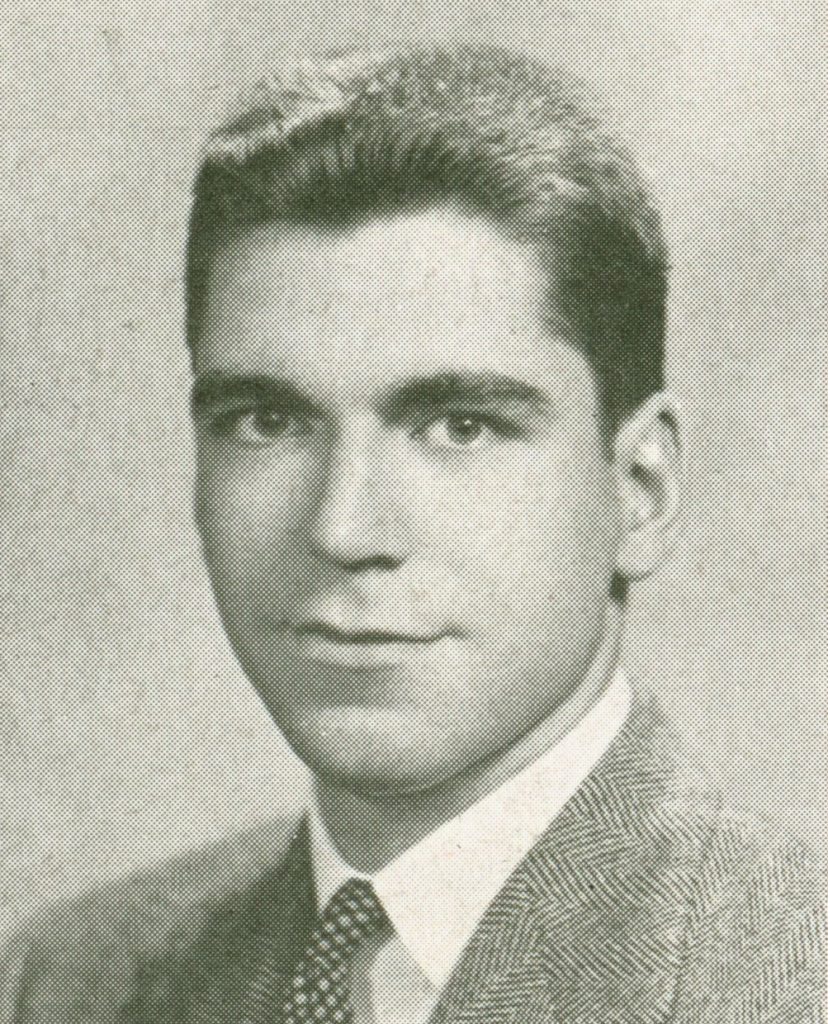
An archivist, a professor and a digital specialist collaborate with students, alumni and each other to tell the stories of the College’s past.
That’s the nickname special collections and archives librarian Susan Falciani Maldonado and assistant professor of media & communication Kate Ranieri bestowed upon Paul Candalino ’43, an alumnus who died in World War II. As the pair reviewed archival materials from that era, Candalino popped up again and again.
“He was president of his class for three-and-a-half years. He was everywhere, involved in everything,” Ranieri says.
“He led scrap-collecting drives. He was an air warden. He was the chair of every committee. He was one of the junior-class escorts for Eleanor Roosevelt,” Falciani Maldonado adds.
They found a photo of his wedding in Egner Memorial Chapel to a Cedar Crest College student, Eleanor Goeringer, in an edition of The Muhlenberg Weekly. They spotted him in some early video footage, dancing to a band that was playing on campus. They learned that he founded the Arcade Magazine, a literary publication, and that he was a member of the Mask and Dagger Theatre Club.
“He kept showing up, so I started doing more digging,” Falciani Maldonado says. She found that he died on the USS Indianapolis, a ship that delivered components for the atomic bomb, at the tail end of the war. “It’s not just that he died; he died in a big way,” she says.
“And in theatre at Muhlenberg, what role did he play?” Ranieri follows. “A man going down with his ship.”
The two women light up as they talk about Mr. Muhlenberg and the other compelling stories they’ve unearthed as they developed the Muhlenberg Memories Project, which shares elements of the College’s history with the public online and at in-person events. The third major collaborator on the project, digital cultures media technologist Tony Dalton, is just as passionate about the subject matter. That’s good, because the three of them have barely scratched the surface of what this project could—and, with their continued enthusiasm, will—become.
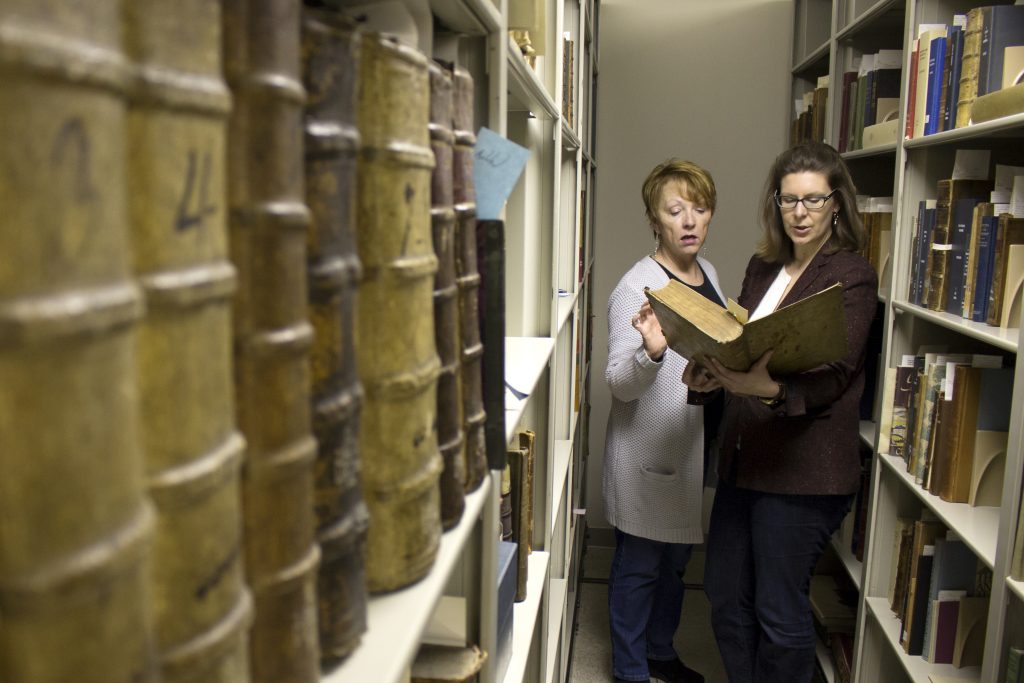
A Trove of Lost Letters
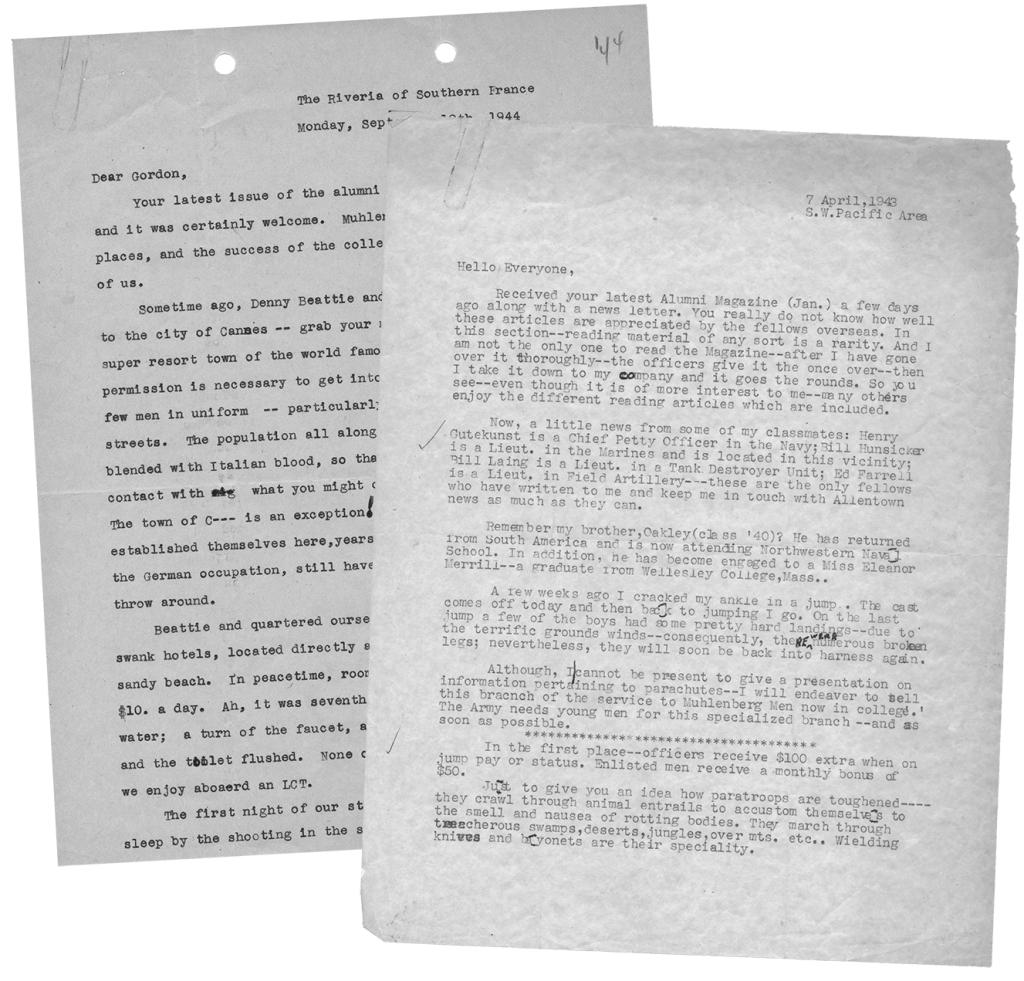
The Muhlenberg Memories Project began with a single exhibit, “From the Four Corners of the Earth: World War II as Revealed in the Muhlenberg College Archives,” that Falciani Maldonado debuted in Trexler Library’s Rare Books room in fall 2014. Shortly after she joined the College that year, her colleagues in advancement handed over more than 1,000 letters to and from Muhlenberg students and alumni deployed in World War II.
The letters came from the heirs of Gordon Fister ’33, Muhlenberg’s first director of public relations who occupied that role from 1937 until 1949. The College received the letters upon his death in 1986, and they’d been divided into each correspondent’s personal alumni files until their rediscovery in 2014.
“That gave me some product, something to process, something to get excited about as a historian and archivist new to Muhlenberg,” Falciani Maldonado says.
Other institutions have some war correspondence in their archives, but this particular collection stands out, she adds: “What none of them seem to have that we do are the carbon copies of the letters the College representatives sent back out. We have both sides, and that is rare.”
The exhibit used some of these letters, as well as other documents and photos from that era, to detail the College’s Navy V-12 and V-5 Training Units, which Muhlenberg hosted from 1943 through 1946. The programs drew students to 131 institutions across the United States whose enrollments had shrunk as young men were deployed. Participants earned a degree in two years and then received military training.
“The exhibit was great, but by the time it came down, we realized it was a bigger story,” Falciani Maldonado says.
A Collaboration Begins
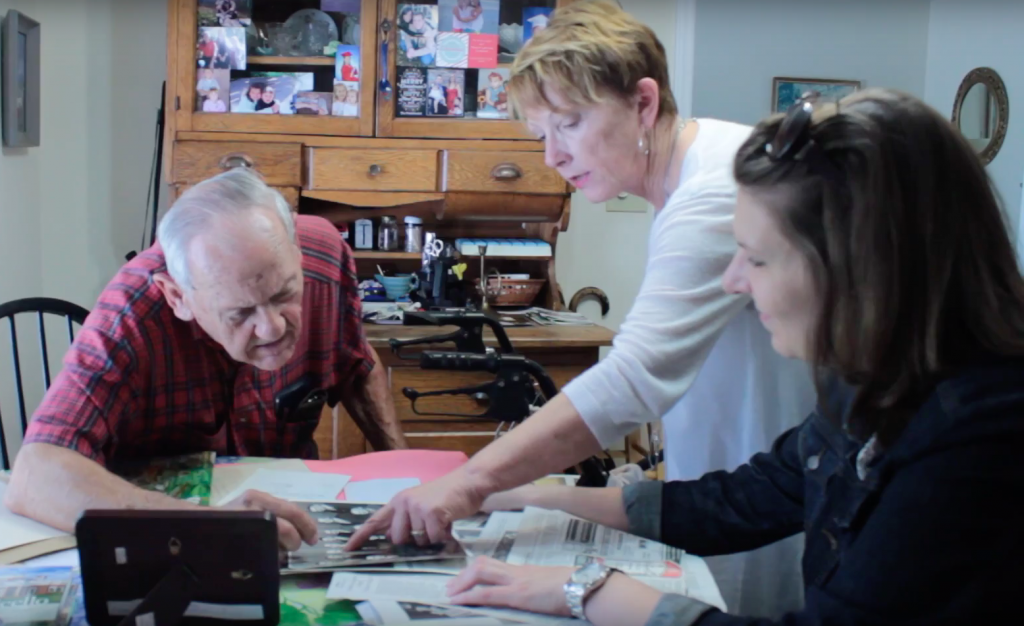
after a sit-down interview
As she assembled the exhibit, Falciani Maldonado began corresponding with some of the veterans she’d found during her research. She saw the multimedia potential—the chance to bring these documents and photos to life by catching up with these men, decades after their military service had ended.
She reached out to Ranieri, who’d been part of the search committee for Falciani Maldonado’s role, to see whether the students in her Documentary Research course would be interested in getting involved. In the summer of 2015, Ranieri spent time poring over the archives, taking notes and finding ample fodder for her students to work with.
Around that same time, it became clear that some of the veterans Falciani Maldonado had been in touch with would be willing to speak on camera. Ranieri asked Dalton, who instructs the Documentary Research labs, if he’d be interested in filming those oral histories. Dalton, who attended World War II airshows in Reading, Pennsylvania throughout his youth, agreed, and “it just grew from there,” he says.
That fall, Ranieri’s Documentary Research students spent time with Falciani Maldonado, exploring the archives to conceive and produce short films about what life was like on campus in the 1940s
“There was a lot going on, and a lot of it had nothing to do with the war,” Ranieri says.
One student explored the on-campus music scene. Another profiled then-College-President Levering Tyson. Others covered campus clubs that no longer exist today, like The Mar Kay Club (for women married to Muhlenberg students), or aspects of campus life that seem foreign to students today, such as the pervasive cigarette culture.

By the end of the semester, in addition to the World War II content from the exhibit and the oral histories Dalton shot, there were a number of short films addressing the same time period. “Kate and Susan said, ‘Hey, we should really build something online,’” Dalton says.
So, Dalton got to work, creating a custom design that would be easy for the others to update. He built a main landing page for what the group was now calling the Muhlenberg Memories Project, which linked to a landing page for The Forties, where all the work created by that point could live. He hand-drew a font—a first for him—based on The Muhlenberg Weekly’s typeface from that era to use in the design.
“It’s a nice, subtle way to nod to that time period,” he says. “A lot of my work stems from, ‘I’m not sure I could do this, but I’m willing to give it a try.’”
Bringing the Past to Life
While Falciani Maldonado and Ranieri have presented this work at conferences on digital scholarship and at this year’s Heritage Alumni Reception & Dinner in September, a Veteran’s Day event at the Sigal Museum in Easton enlivened the archival material in a whole new way.
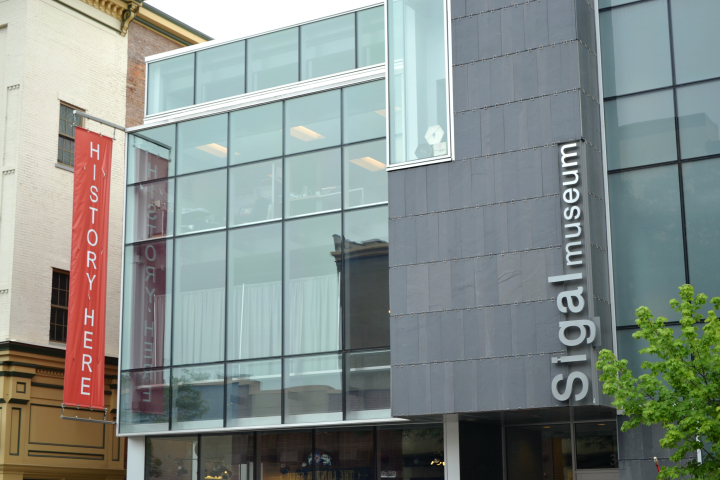
photo courtesy of residenttouristbethlehempa.com
Ranieri reached out to students in the Muhlenberg Theater Association after seeing a clip of a Chapman University student doing a dramatic reading of a letter from one of its alumni, sent while he was being held as a prisoner of war. “If he’s doing it, our theatre students could do it,” Ranieri thought.
So, on November 12, a group of 12 theatre students traveled to Easton to do dramatic readings of a handful of Muhlenberg letters from World War II. Dalton, who was there to record the performance, was once again required to put on a new hat: When one of the students didn’t show, Dalton stepped in to read in his place. He (and the students) must have done just fine, as they’ve since been invited to recreate the performance elsewhere.
“Theatre students wouldn’t have any other reason to get into this,” Ranieri says. “I don’t think any of them had ever been in the Rare Books room.”
The only limiting factor on the Muhlenberg Memories Project seems to be manpower— “We have grand ideas of how big this could be,” Falciani Maldonado says. “We need a staff because we do all have day jobs” —so the more students they can involve, the better.
Looking Ahead on Looking Back
“I’d like for this project to branch out so students get involved with knowing their history,” Ranieri says. “It’s their College, their second family, and I think they really start to see that.”
Her Documentary Research students have continued working with the archives each semester to produce new content, with each section of the class organized around a theme. For example, students last fall explored the histories of the buildings that existed on campus during the 1960s. That work was just added to the Muhlenberg Memories Project page on a sub-site called Under Construction, a nod to a well-known web-design device. Going forward, the Muhlenberg Memories Project team would like to cover all the decades of the 20th century.
Falciani Maldonado, Ranieri and Dalton would also like to get more alumni involved. Some are already: At Alumni Weekend this year, one of the “lifelong learning” opportunities was to help transcribe some of the World War II letters that have been scanned into the Project’s database. Twenty or so alumni participated, and some continue to help through a portal they can access remotely.
Alyssa Hertel ’18, a media & communication major who took the class when students first started working with the archives in fall 2015, produced a documentary about sports at Muhlenberg in the 1940s.
“Digging through old yearbooks and letters and pictures, and then working with all the stuff that Mike Falk in sports communications had, like statistics and game sheets from those games, was amazing,” Hertel says. “It showed me there was so much more to Muhlenberg than what we see now.”
Alyssa Hertel’s project: The Dream Season
The team would also like to continue inviting alumni to speak directly to Documentary Research students. “Students love it when the alumni come to class,” Falciani Maldonado says. “‘Did girls really have to wear skirts all the time?’ They ask questions like that and get responses from people who lived through another era. Alumni always say, ‘My story isn’t actually special—’”
“—until they’re walking out of Walson Hall,” Ranieri interjects.
“This is history for these students,” Falciani Maldonado adds. “With this project, with as many of the classes we can use the College archives in, we show that their four years here is on this continuum, that they’re part of something bigger.”
Mr. Muhlenberg, Revisited
The Muhlenberg Memories Project team has found themselves part of something bigger, too, on at least one memorable occasion. When Falciani Maldonado first discovered Paul Candalino in the archives in the summer of 2014, she Googled him and got nothing. That fall, as the World War II exhibit was running, a military historian from Candalino’s hometown of Hawthorne, New Jersey, Paul Chepurko, published a book that included short biographies of small-town veterans from that era. Candalino was one, so Falciani Maldonado contacted the historian, who gave her some more information.
Candalino had been stationed in Asbury Park, New Jersey., after his wedding on campus, but “he wanted to serve his country more, so he requested active duty,” Falciani Maldonado says. “His wife went out to visit him in California before he sailed on the Indianapolis. She was one month pregnant when he died.”
The historian put Falciani Maldonado and Ranieri in touch with Candalino’s son, Paul Jr., who lives in California. On November 11, 2015, a street in Hawthorne was dedicated to Candalino. The Muhlenberg Memories Project team was able to meet Paul Jr. there, and Dalton filmed the event. A student later used that footage in a documentary about Candalino.
“This guy never knew his father,” Falciani Maldonado says. “He’d never seen his father’s senior yearbook, so I sent him that. And he sent me Paul’s letter sweater.” Now, the two correspond a few times each year.
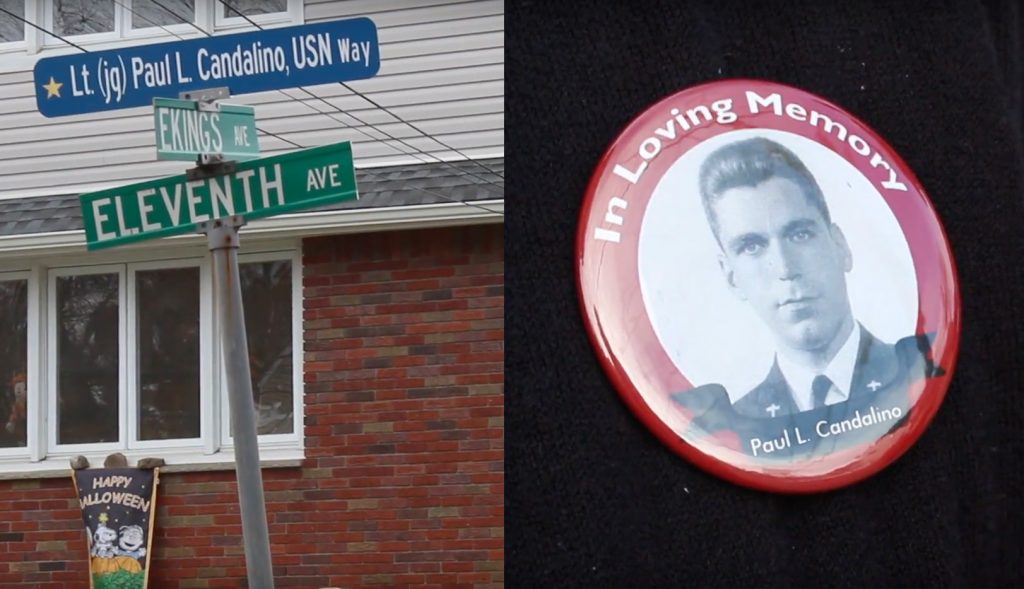
“One of the greatest things about this collaboration is that we all get a sense of joy out of it, and all those moments connect to each other,” Dalton says.
“Susan finds something cool, Kate finds how to connect it with the classroom, I find how it could be shot or presented: All of those joys connect. It just makes for some of the most fun work I’ve ever done here.”
“With this partnership, I kind of want to make people jealous of just how much fun we’re having and how much there is actually involved with it,” he adds. “It’s a model I definitely hope carries into other people’s work here on campus.”

